Transport Scotland & West Dunbartonshire Council Roads position on the development
Road safety and traffic impact assessments are a standard part of development planning and the authorities responsible for roads are consulted by Planning Authorities as a matter of course. Both Transport Scotland, responsible for the A82 and the strategic transport network, and West Dumbartonshire Council (WDC), responsible for the roads and parking in the village responded quickly to the application. Surprisingly neither response had anything substantive to say about the traffic and parking implications of what is a major development.
TransportScotland (see here) said nothing at all, they just ticked a box labelled “The Director does not propose to advise against the granting of permission”. Road transport is responsible for much of our carbon emissions but despite the Scottish Government’s commitment to reduce those emissions, TransportScotland appears unconcerned about the likely impact of Flamingo Land on this let alone atmospheric pollution.
One might have at least hoped they might have commented on the Transport Assessment conducted by Flamingo Land which implies the development will have little impact on the trunk road network. This will come as a surprise to anyone has tried to use the A82 regularly at peak periods like Bank Holidays. Southbound traffic can snarl up from Dumbarton back to Luss and beyond with pinch points at places like Cameron House where vehicles try to join the main road. It should be obvious that creating a major visitor attraction at Balloch will impact on those problems so why hasn’t TransportScotland commented? The answer (see below) is they appear to be party to the assessent although nowhere is this stated in their response.
West Dunbartonshire Council roads services response was not much better, most of the tick boxes on their standard form were left blank, except those which stated they had no objection and required no further information on the traffic or parking implications. There was, however, some information in an appendix: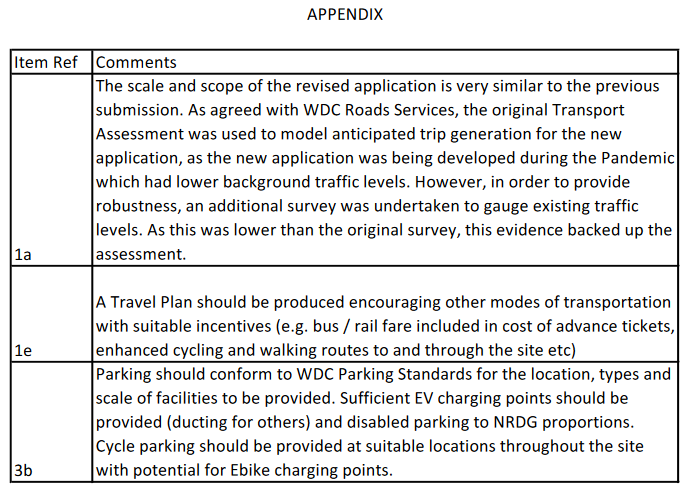
It appears from this that WDC did not check whether the various numbers quoted in Flamingo Land’s application for increased traffic and parking added up but simply accepted them.
Like TransportScotland, WDC road appear to have little idea we are in a climate emergency – what does “sufficient EV charging points” mean? – and no concern about what impact the development might have on parking by local residents and businesses.
In effect through their responses TransportScotland and WDC roads dumped all responsibility for looking at the traffic and parking implications of the development to the LLTNPA. That neither had done their job properly was confirmed in the letter the LLTNPA sent to Flamingo Land’s agents on 17th November asking for further information on numerous aspects of the development including traffic and parking:

Stantec, the agents for Flamingo Land, have not yet replied to that.
Illustration of flaws in the Transport Assessment
The original Transport Assessment conducted on behalf of Flamingo Land and referred to by WDC in their response took place in 2017. Rather than requiring a full new assessment, WDC asked for a limited new survey to “check” the applicability of the previous data. When the repeat survey purported to show that traffic in Balloch had dropped, WDC roads endorsed the 2017 survey as a suitable basis for taking planning decisions.
The drop in car numbers may come as a surprise to people who visited the village post lockdown but there is a good explanation for this, the new traffic surveys were not comparing like with like and don’t provide data for holiday periods. This is explained in the revised Transport Assessment (Vol 2 Appendix 12.1 to the Environment Impact Assessment (see here)

While the original survey was for early September, still the holiday season, the repeat survey was in November and the second half of the month at that.
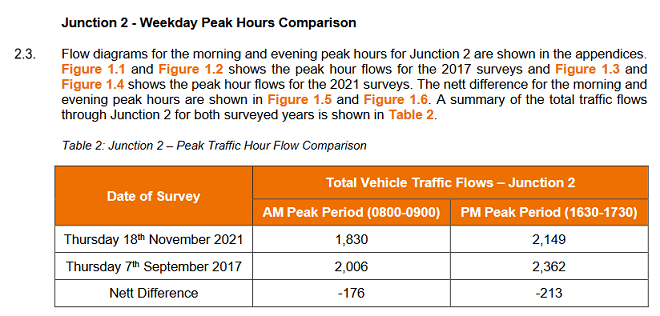
The only surprise for a village which attracts traffic in the holiday season is the drop wasn’t even bigger! In terms of the validity of the survey, it is also worth noting there was no comment about the weather on either day which could also impact on the results.
The other key point to note is that WDC and TS both advised Stantec (para 7.1.5) they should focus their surveys on non-peak periods to provide a “neutral” assessment according to industry standards, ie an indication of mean traffic travels during the course of the year. That approach is far from “neutral”. For people trying to get to Balloch or living there, it is peak periods of the holiday season which is what matters. What happens outside the tourist season is irrelevant if the village is gridlocked and has insufficient parking at peak periods: two months of traffic hell is not compensated for by the ten months of the year the roads have sufficient capacity. The LLTNPA planners have rightly asked for STANTEC to clarify the impact of increased traffic on delays and queuing.
The Transport Assessment, which is 40 pages, is accompanied by over 160 pages of data from traffic surveys which appears to be of dubious worth. What one can say, however, is that the proposals from Flamingo Land to create 393 new parking places suggest they anticipate a considerable increase of traffic to the village.
NPF4, traffic reductions and the Flamingo Land development
In January the Scottish Parliament approved a new planning framework for Scotland, National Planning Framework 4, and earlier this week, on 13th February, this was adopted by Scottish Ministers and replaces previous guidance. The LLTNPA had delayed replacing its Local Development Plan (LDP), 2017-21, which was used to evaluate all planning applications in the National Park, on the grounds that it needed to align with the new national planning framework. What the adoption of NPF4 means is succinctly summarised on the Scottish Government website (see here):
“The statutory development plan for any given area of Scotland consists of the National Planning Framework and the relevant local development plan(s).”
With its LDP so out of date, the LLTNPA’s primary reference point for evaluating Flamingo Land’s development proposals at Balloch is likely to be NPF4. This puts the reduction of the climate and nature emergencies at the centre of the planning system, starting with Policy 1:
“When considering all development proposals significant weight will be given to the global climate and nature crises”
Hence why the very last point of LLTNPA’s letter to Flamingo Land asking for further information on 17th November was to request an assessment of their proposals in the light of NPF4.
Under Sustainable Places NPF4 goes on to state:
“Scotland’s Climate Change Plan, backed by legislation, has set our approach to achieving net zero emissions by 2045, and we must make significant progress towards this by 2030 including by reducing car kilometres travelled by 20% by reducing the need to travel and promoting more sustainable transport.”
Whereas NPF4 is aiming for a reduction of car traffic by 2030, Stantec in the Environmental Impact Assessment carried out by Stantec for Flamingo Land first assumes that traffic will have increased by 2030 over the levels they recorded in 2017:
“A year of opening assessment of 2030 was based on all development being operational in
accordance with Transport Assessment Guidance 2012. . Given the time between the traffic surveys carried out in 2017 and a year of assessment of 2030, a factor was applied to the 2017 surveys to reflect an increase in traffic over a period of 13 years.”
The Transport Assessment Guidance is very out of date and no longer fit for purpose but it resulted in this revised baseline for 2030:
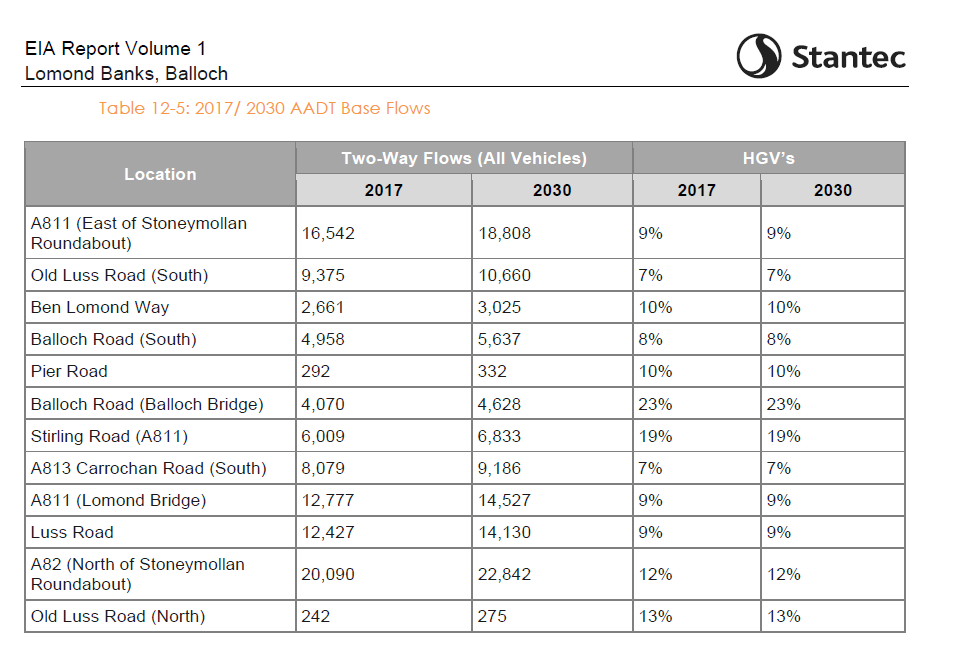
On the more frequented roads that is an increase of over 10% from 2017 levels. Then, on top of this increase, the Environmental Impact Assessment predicted the development would generate the following vehicle journeys each day:

This is estimated to result in the following increases to traffic on the local road network:

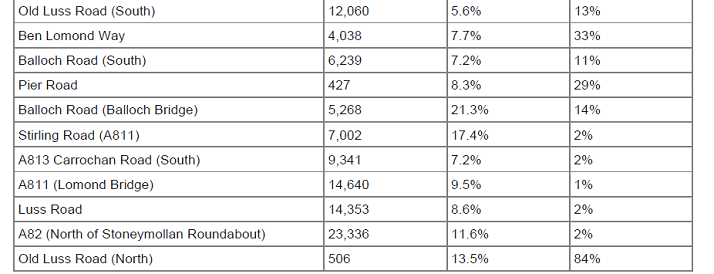
Combine the two projected increases and traffic on the A811 into Balloch from the Stoneymollan roundabout is projected to increase by 30% when the Scottish Government is looking for a 20% reduction across Scotland!
While one could question how 393 new parking spaces will be sufficient to deal with this increase in trips, if the LLTNPA approve them they are likely to blow any chance they have of meeting the Scottish Government’s targets by 2030. Reducing car use in rural areas by 20% is going to be hard enough without the LLTNPA having to compensate for an influx of cars to the so-called gateway to the National Park which is better served by public transport than any other settlement.
Both Transport Scotland and WDC Roads knew this because the 20% car reduction target was included in Scotland’s revised Climate Change Plan 2018-32 when it was revised in December 2020 and should have advised Stantec accordingly. It makes their “non-responses” to the planning application even more culpable.
So how do Flamingo Land’s transport proposals measure up to the policies in NPF4?
While the traffic reduction target is given prominence in NPF4, it is not framed as a planning policy as such because that would, for example, stop new housing developments where some increase in traffic is unavoidable. There are, however, a number of policies under the Tourism and Sustainable Transport chapters of NPF4 which appear designed to stop the sort of development proposed by Flamingo Land in it application for Planning Permission in Principle ((PPiP), for example:
1) Policy 30 Proposals for tourism related development will take into account:
iv. Opportunities for sustainable travel and appropriate management of parking and traffic generation and scope for sustaining public transport services particularly in rural areas;
vi. Measures taken to minimise carbon emissions;
13 d) “Development proposals for significant travel generating uses will not be supported in locations which would increase reliance on the private car, taking into account the specific characteristics of the area.”
Comment. Flamingo Land’s proposals will increase traffic and, by doing so unnecessarily, won’t do anything to wean people off their cars and onto public transport. For example, the clear assumption is that the people staying in the 105 accommodation units at Woodbank House up the hill will do so by car as there are NO proposals to transport people there from Balloch Station or the pierhead by bus.
2) 13 e) Development proposals which are ambitious in terms of low/no car parking will be supported, particularly in urban locations that are well-served by sustainable transport modes and where they do not create barriers to access by disabled people.
Comment. The plans contain no proposals to reduce car travel through car parking and use parking standards agreed before the declaration of the climate and nature emergencies.
3) 13f) Development proposals for significant travel generating uses, or smaller-scale developments where it is important to monitor travel patterns resulting from the development, will only be supported if they are accompanied by a Travel Plan with supporting planning conditions/obligations. Travel
plans should set out clear arrangements for delivering against targets, as well as monitoring and evaluation.
Comment. The EIA contains one paragraph about a Travel Plan which reads as follows: “Contained within the Transport Assessment an Outline Travel Plan incorporates actions and incentives and an ongoing programme of delivering sustainable travel options for the proposed development site. This includes several potential measures which could be implemented to support sustainable travel choices for future employees, through both induction processes and provision of a travel information pack for new starts. This would also include the provision of a Residential Travel Information Pack for the residential component of the site, which will be issued at point of occupation.”
Flamingo Land want to create a service area, Area 10 in the application, in ancient woodland which will contain no less than 35 parking spaces for staff and services! As for the Residential Travel Information Pack it appears it will be issued once visitors have arrived……….. in their cars!
4) 13g) Development proposals that have the potential to affect the operation and safety of the Strategic Transport Network will be fully assessed to determine their impact. Where it has been demonstrated that existing infrastructure does not have the capacity to accommodate a development without adverse impacts on safety or unacceptable impacts on operational performance, the cost of the mitigation measures required to ensure the continued safe and effective operation of the network should be met by the developer.”
Comment. Having stated that the traffic surveys were conducted in neutral periods the EIA does, to Stantec’s credit, in discussing road accidents in the local area make a comment which indicates the likely impact of the development on the road network at peak times:
“A82 (North of Stoneymollan) – two serious incidents reported on the approach from the north to the Stoneymollan Roundabout, albeit more remotely.
This section of route is notorious for queuing and delay as a result of exceptionally heavy traffic volumes, which may have contributed to the incidents and propensity for occurrence in this location.”
The Sustainable Transport chapter of NPF4 also includes a number of policies designed to promote use of public transport and active travel rather than cars. Flamingo Land’s proposed development does little to promote these aspiration apart from incorporating the existing long distance walking and cycling routes into the development:
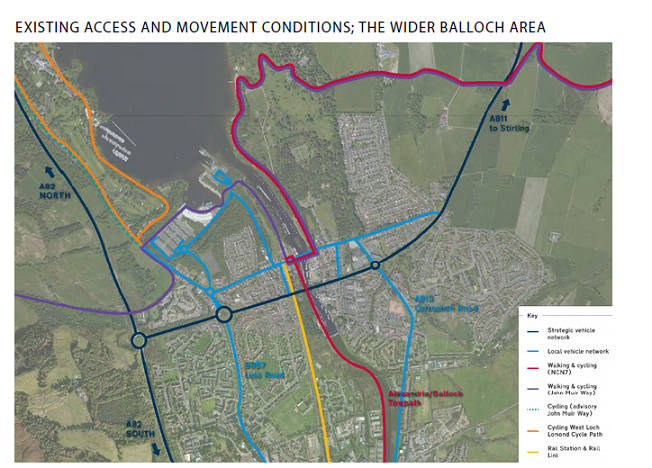
What the Planning Application lacks are meaningful proposals to shift the number of visitors who are likely to arrive by car as promoted by the policies in NPF4. For example:
5) 13 a) Proposals to improve, enhance or provide active travel infrastructure, public transport
infrastructure or multi-modal hubs will be supported. This includes proposals:
i. for electric vehicle charging infrastructure and electric vehicle forecourts, especially where fuelled by renewable energy.
Comment: there are no details in the PPiP
ii. which support a mode shift of freight from road to more sustainable modes, including last-mile delivery.
Comment. The large service block in area 10 appears entirely served by vans/lorries
The PPIP also lacks detail about how existing infrastructure will be improved as suggested in Policy 13b of NPF4:
- There is nothing on the potential to improve public transport. For example if the development had been designed around visitors arriving by train, not car, those numbers could have been used to justify an improved train service to Balloch;
- The proposed monorail from near the station to the pierhead area appears designed as a tourist attraction, no doubt with prices to match, rather than an extension of the public transport system designed to make the Pierhead Area and Loch Lomond shores more accessible (small electric buses or buggies, as seen on the continent, would do that far more effectively;
- There is no mention of where people cycling to the various lodges can store their bikes that I can see or where electric cycle charging points will be located;
- Traffic on site will increase contrary to the aspiration of NPF4 to create safer “crossings for walking and wheeling and reducing the number and speed of vehicles”;
Discussion – transport, green tourism and Balloch
Setting aside for now arguments about the scale of Flamingo Land’s proposed development and the impact this would have on the natural environment and local community, Balloch has considerable potential to act as a green gateway to the National Park. What this would require, however, are improved train connections (e.g. every 20 minutes instead of half hourly), good bus connections onwards up either side of Loch Lomond (almost non-existent) and facilities designed to appeal to cyclists and water sports enthusiasts in particular. It would also require active measures to discourage visitors arriving by car.
That sort of vision for Balloch would be supported by NPF4 but Flamingo Land’s current application for PPiP will do little or nothing to deliver it. Instead the application assumes increased traffic, with all the harms which that causes. There is no need for this. There are tourist resorts on the continent, such as Zermatt in Switzerland, that can only be accessed by public transport or active travel and they work very successfully.
The problem for any future development in Balloch, whether by Flamingo Land or not, is that the village is already swamped by traffic and its spaces dominated by car parks. Until that is tackled, the potential to create a green development will be highly constrained as visitors can always decide to brave the traffic chaos knowing that there will be somewhere to park. It is almost impossible to control this which is what has led Loch Lomond Shores objecting to Flamingo Land’s PPiP: it is concerned their customers will fill up its car parks. What is needed is a green transport plan for Balloch as a whole but that cannot be done by a single developer, it requires co-ordinated action from our public authorities.
The LLTNPA should have every reason to reject Flamingo Land’s application for PPiP on the grounds of the traffic implications alone but until it stops being reactive, takes a lead and starting acting like a National Park the transport aspirations of NPF4 as they should apply to Balloch will never be delivered. My next post will look at the implications of Flamingo Land’s proposals for new car parks within the context of Balloch as a whole and the needs of its residents, businesses and visitors.

Those who live further north or west, might just (as others can) wish to reach Scotland’s second city, Scotland’s busiest airport or access motorways leading south. The area around Balloch has regularly become a considerable bottleneck. Even for those who now leave their cars at home, and agree to use the Fort William /Skye bus service towards Glasgow, the potential for delays due to traffic build-up at the south end of Loch Lomond are frequent and of unpredictable duration. This means that to reach the airport an earlier bus south has to be booked. Consequent to the inadequacies of the A82 to serve whole Highland communities a whole extra half day will be necessary for each excursion, often wasted blandly sitting around. In peak times it becomes an unlikely event the bus can ever be run exactly on schedule. I can contrast this with simple and speedy access to Schipol, within 75 minutes (over a similar distance as from Fort William) across Holland. Train and bus services across NL operate on predictable and precise schedules. These are so precisely scheduled the carriages will depart those who were waiting but move too slowly to get on. Scotland’s west highland infrastructure fails this backward “leading nation” Any development that adds to duration of congestion and snarl-ups along the arterial route near Balloch must be properly addressed.Overdue mitigation by officials at Transport Scotland is a duty. They should pay full attention.
WDC is amazing. One time they dumped tons of old tar road surface scrapings at Sandpoint on the R. Leven/Clyde. They claimed the material was “inert.” It was part of a land raising exercise on the floodplain so Docherty, the boat guy, could build houses there. Nothing’s happened yet, though they were about to build a new school thereabouts and that got the boot. Also WDC had to be involved when the angling assoc. dumped tons of demolition rubble into the R Leven at Bonhill Bridge. Only in WD. The angling assoc. also dumped huge boulders into the R Leven “to stop poachers.” That put a stop to the boats using it like they did before. The boats never liked the slipway set-up at The Gates/the barrage….the NP Boundary. Even less, now Scottish Water won’t assist unless they’re insured. We all found out who “the poachers” were after I submitted a Crime Report to the PF….about the angling assoc. The amount of lying that goes on is OTT. The public don’t realise how much people get paid to talk rubbish. Still, at least the “R Leven Canal Plans” look to be dead and buried. That was cuckoo!